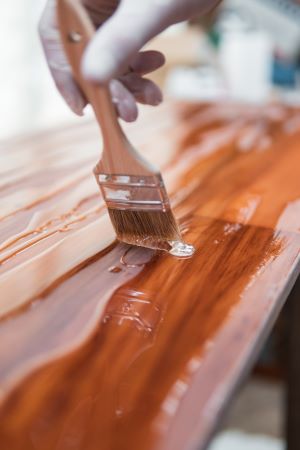
The quick answer to how long polyurethane takes to dry is about day. However, the long answer goes over types of surfaces, drying versus curing time, influencing factors, and much more. Get all the facts to know how long your final layer of wood cover should take to dry and get your project done right the first try.
Polyurethane
If you are very new to woodworking, you may not know the purpose of polyurethane. Basically, polyurethane is a liquid plastic that dries to a solid finish. The liquid plastic comes in oil-based or water-based, with different benefits for each. Both dry at different rates but work for varied purposes.
Water-Based Polyurethane
With water-based polyurethane, you get a dry time as low as six hours. Moreover, it’s popular because it’s has a low odor and toxicity level. The problem is you need to use the water-based option on indoor items like bookcases, desks, and frames. It’s not smart to use this option for items exposed to extreme weather.
You can use water-based polyurethane on a floor as well as furniture and get a dry time of about 6 hours. Add another coat and wait a full day before you can walk on the floor on a whim with socks. Wait another two days to put your belongings back in place but keep pets and kids off the floor a full week.
Oil-Based Polyurethane
Oil-Based Polyurethane can handle any weather but take about 24 hours or longer to dry. You need good ventilation and a respirator to work with this strong and toxic finish. Keep in mind the oil-based option has a slight yellow tinge of color and is not as clear as water-based poly.
For floors, you want to let the polyurethane dry for one to two full days before even stepping on the surface. Keep kids and animals away, send them to stay with a family member during the time. Wait at least four days before moving furniture items on your floor but keep children and animals away for another couple of weeks to allow the floor to cure, which takes a full month. If you can, apply the polyurethane and then go on a vacation for a month for the best results.
Drying and Curing – Know the Difference
Drying and curing are not the same thing. The finish may be dry, as in no longer tacky or wet in appearance, but not cured. You still need to be gentle with the wood item or floor at this point to prevent problems with curing. A chemical change has to happen to consider the item cured. Each coat adds to the amount of time it takes to cure, and the process can take several weeks. If you can smell the poly, then it’s still curing.
Influencing Factors
Many factors can affect the drying time of the two types of poly. From the type of surface to the weather, you need to consider several factors before starting your process. Plan accordingly to ensure you can leave the right amount of time for the drying process.
Type of surface
Polyurethane can go on wood and over paint. You can use it on smaller projects too. Typically the time to dry does not change drastically on wood or paint. Do make sure the paint is completely dry before applying the poly. With any surface, start with a thin first layer and allow to dry completely. Apply a second or even a third coat after and allow to dry in between coats. Finally, allow the item to cure completely before using.
Also, different wood reacts differently as well. Some woods take longer to dry with the polyurethane, including cedars and rosewoods too.
Humidity and Temperature
Working in extreme heat does not work for polyurethane, nor does extreme cold. Instead, opt for 70-degree weather and humidity between 50 to 70 percent. The lower the humidity, the faster your projects will dry. With colder or more humid temps can take longer to dry.
Types of Sheen
Different sheens can take longer to dry too. You have three options – satin, semi-gloss, and high-gloss. The more gloss, the longer the finish will last and the tougher it will be too. Of course, the more sheen, the longer it will take to dry as well.
Coats of Polyurethane
Sand between layers and expect lighter coats to dry a little faster. Make sure to allow coats to dry completely between layers, as this will allow for better bonding and curing. Make sure to sand lightly with fine-grit sandpaper in between layers too. Ensure the polyurethane is dry before sanding, too, as it will cause smoothness issues.
Plan for two to three coats of polyurethane for the best finish. Each coat makes the surface smoother and stronger. No matter what surface, you need to wait a full month for the project to cure for both water or oil-based polyurethane.
Safety Precautions
Oil-based polyurethane causes respiratory problems as it is a toxin. People with asthma need to be extra careful. Do not work with oil-based polyurethane without wearing a protective mask and a well-ventilated room; otherwise, you will be the one in need of a cure instead of your wood project!
Speeding Up the Drying Process
Sorry, there is no real way to speed up the drying time on polyurethane. You can put on thinner layers as they will dry faster, but you will need more coats, and it will still take the same amount of time to cure.
Final Thoughts
While you need to take several factors into consideration, oil-based polyurethane takes about 24 hours to dry, while water-based polyurethane takes about six hours to dry. Both take 30 days to cure before you can use the items. Plan accordingly so you can use your item when you need it. When dealing with floors, plan extra time to avoid a poor finish.